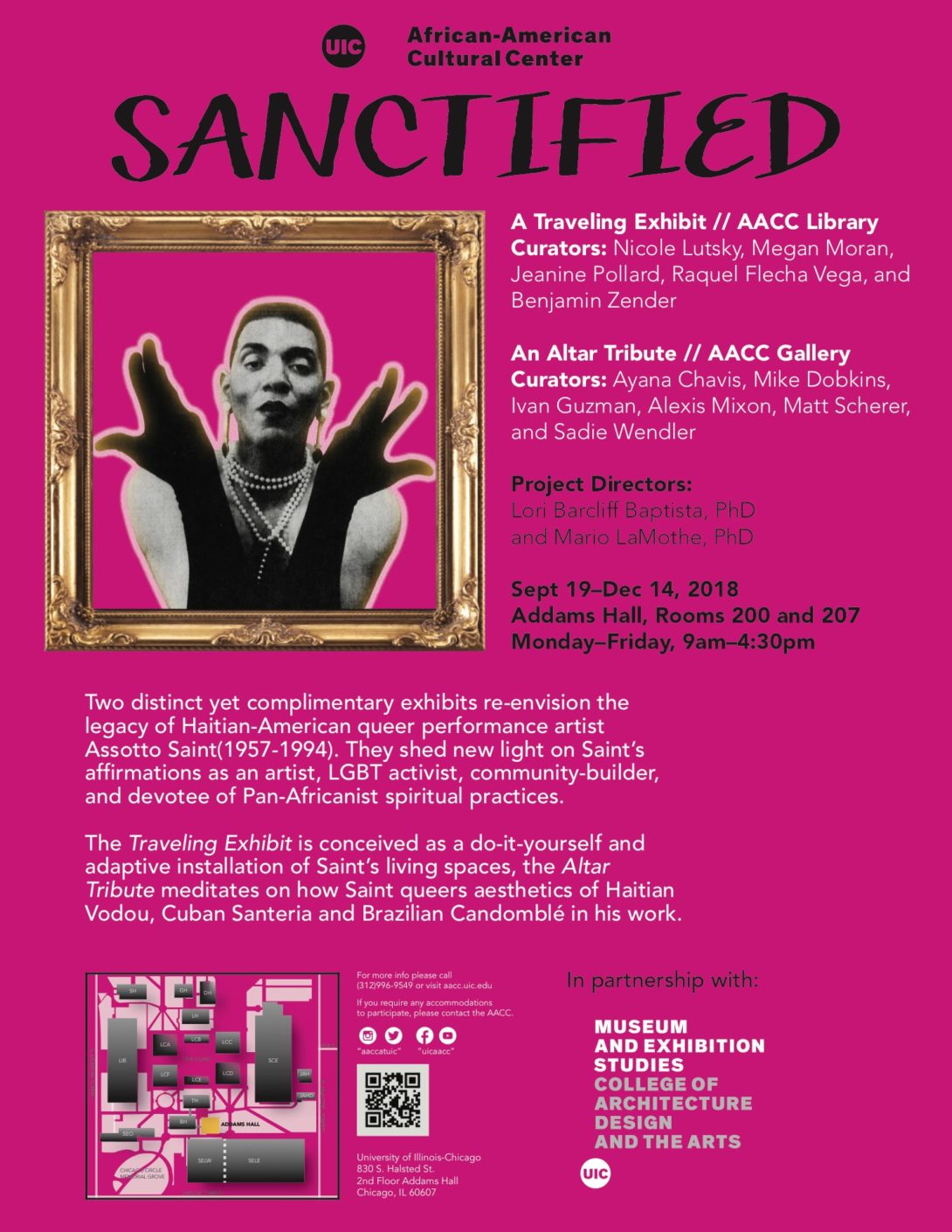Sanctified I & II
Sanctified
September 19 - December 14, 2018 / AACC Gallery & AACC Library
Sanctified is an exhibit to increase public knowledge of the contemporarily famous gay black author and black and gay rights activist Assotto Saint (b. Yves Francis Lubin) and introduce visitors to news way of thinking about Afro - Diasporic religion. Sanctified searches for guidance and healing through the imagery and evocation of vodou. The use of color, alters, and the synchronization of Assotto Saint with vodou Ioa (Iwa) connect the visitor to Saint in physical and spiritual transformation that can be found in the reinvention of self and the practice of ancestral religion. The exhibition blends the spectacular and transformative nature of vodou with the spiritual release found in the performative self.
Assotto Saint

Born Yves François Lubin and marked by his childhood as a ridiculed effeminate same-sex desiring boy in Haiti, Haitian-American performance artist Assotto Saint gained recognition in New York Theatre at the onset on the AIDS pandemic for his sexually explicit brand of radical poetry and choreographed plays. The former member of the Martha Graham Dance Company lisped, minced, pranced and threw shade as he commandeered the page, the stage, radio stations and marches to denounce psychological and physical violence on black bodies brought on by HIV/ AIDS, homophobia and anti-Haitian sentiments. Despite his relevance at the peak of his popularity, Saint’s works are now rarely performed. Set against the backdrop of late 20th century U.S. based social and cultural movements as well as queer African-American and Haitian histories, the African-American Cultural Center exhibitions aim to rekindle public memory of the activist.
Assotto Saint was a critical figure in the African American and LGBT literary and arts movements of the 1980’s and early 1990’s. Assotto Saint is unique to the movements in his ability to transform himself at his own will, to command authority over his truth as a gay black man in the United States, and to capture the visceral pain of loss and fear of dying due to HIV/ AIDS. Saint fearlessly condemned the United Sates’ abuse of black and gay populations and the demonization of communities affected by HIV/ AIDS.
The historical emphasis on his work and his legacy does not reflect his contemporary influence in the respective cultural movements and the present-day power his work and life story possess. Sanctified seeks to catalyze the circulation of his work and the resurgence of Assotto Saint as a black and gay liberation figure.
Sanctified
The programming for Sanctified will attempt to enliven the exhibition by bringing Assotto Saint more concretely into the room. To do this, the programming uses the idea that Saint himself was a kind of contradiction; someone that stood strongly for his ideals to the point of being unafraid to call out popular figures within the movements that represented those ideals. The programming brings in as many perspectives as possible to showcase the intersectionality of Saint’s identity, hoping to represent the diversity that he embodied while refraining from speaking for him directly. Programs will happen in the festive spirit that Saint represented. As forces for creativity, they will seek to actively strengthen the creative, black, and LGBTQA communities in Chicago including all of the places that those intersect. Each program is also carefully planned around dates that correspond to facets of Saint’s identity, whether that is the AIDS movement, his birthday, or Halloween; an opportunity to showcase the kinds of pageantry with which Saint lived. By appealing to the many facets of Saints personality to create this programming, the goal is to also appeal to a wide variety of people who could be interested in or inspired by Assotto Saint’s life and work.
Sanctified
This exhibit not only invites audiences to explore the life and works of a relatively unknown, but important, historical figure in their area of work and interest, but also invites to participate in collaborative ways with others who are similarly interested in this work through different levels of engagement. The exhibit design invites visitors to reflect on the power of self-transformation, identity, and healing through ancestral religious practices in a participatory way, where they may also contribute their thoughts, feelings, ideas on the subject by adding physical objects to the altar during specific exhibition programming.